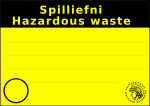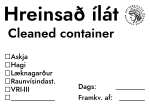It is University of Iceland policy to comply with international regulations on environmental issues and the disposal of biospecimens and hazardous waste. Many chemicals used at the University are harmful to the environment, humans and animals. This means that it is necessary to sort all refuse and hazardous waste correctly and send it to be disposed of by recognised parties.
Each University building has a single area where hazardous waste is gathered. These materials may be toxic, harmful to human health, corrosive, carcinogenic or infectious. When sorting them, consider their behaviour and reactivity. It is important to realise that some chemicals must not be mixed under any circumstances and that others must be detoxified before being sent for disposal.
Every chemical has a safety data sheet (SDS) containing information on how to handle the chemical and how to react if you come into contact with it. The SDS will be available on the manufacturer's website. If you are not sure how to dispose of a certain chemical, contact the laboratory manager or a member of the relevant health and safety committee.
At the University of Iceland, hazardous waste is sorted according to its properties and labelled with the appropriate symbols, as in this table.
It is important to choose the correct container for hazardous waste.
- Do not use glass flasks for hazardous waste. Pressure may build up inside the flask and glass may shatter, but plastic containers will not. Of course, this rule does not apply if the chemical melts plastic.
- Do not use metal containers for hazardous waste; acids and alkalis corrode metal.
- Do not fill a container above 80-90%.
- Close containers tightly when they are full and leave them in the waste collection area in your building.
 It is important to label containers of hazardous waste carefully. Include the name(s) of the chemical(s) and a letter indicating which category they belong to. Note than abbreviations such as MeOH or HC1 are not sufficient – you need to write the name of the chemical. Use the HazMat stickers and stick them over the older labels on the container.
It is important to label containers of hazardous waste carefully. Include the name(s) of the chemical(s) and a letter indicating which category they belong to. Note than abbreviations such as MeOH or HC1 are not sufficient – you need to write the name of the chemical. Use the HazMat stickers and stick them over the older labels on the container.
Chemicals must be stored in a single area of each building, where they are collected by a authorized company and taken for incineration or landfill.
All biological waste from labs working with biospecimens, microorganisms, research animals, biological agents and genetically modified organisms must be disinfected or sterilised before leaving the building.
Infected needles, blades or glass shards must not be placed in a bag with other infected waste under any circumstances. Sharps pose a significant risk to anyone transporting or sterilising the waste. All sharp objects should be handled with particular caution; see the section on sharps waste.
Needles and blades used in practical courses or in the research lab should be placed in a special box and then disposed of intact. Entire syringes with needles may be placed in the boxes. The boxes must be sterilised before they are taken out of the building.
Glass that is not sent to be recycled, as well as broken glass, is placed in a special container. Infected glass must be sterilised first. Contaminated glass chemical containers must be rinsed out and dried before being thrown away.
Infected needles, blades or glass shards must not be placed in a bag with other infected waste under any circumstances. Sharps pose a significant risk to anyone transporting or sterilising the waste. All sharp objects should be handled with particular caution.
 When empty packaging is discarded, it must be observed that empty packaging with hazard labels is considered hazardous material and should be dealt with accordingly.
When empty packaging is discarded, it must be observed that empty packaging with hazard labels is considered hazardous material and should be dealt with accordingly.
In order to avoid placing the packaging in the hazardous waste category, it must be cleaned and marked separately as a "cleaned container" with a special label that must be pasted over the existing hazard markings on the packaging.
University of Iceland staff are responsible for sorting waste resulting from teaching or research. They must ensure that students and other staff follow rules about sorting, storing and disposing of chemicals.
